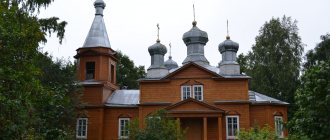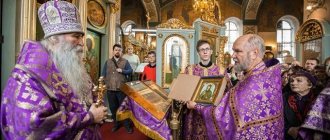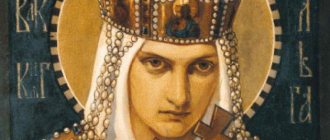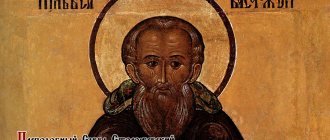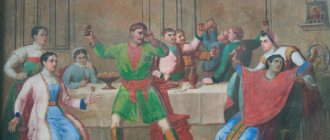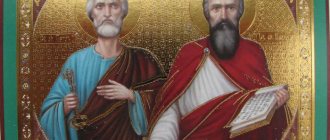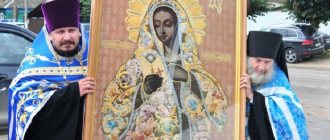Confessor of the Lord
Despite the fact that Christians of those times were subjected to terrible persecution, Paraskeva continued to preach the faith of Christ. Many young men, seeing the immaculate beauty of the saint, offered her to marry and worship the idol in order to save their lives and not be subjected to cruel torture. But the Great Martyr Paraskeva Friday always answered that the one God is Jesus Christ and He is her only Bridegroom. Some townspeople, thanks to the saint, converted to faith, while others reproached her for such sermons.
One day, Diocletian ordered his subjects to go through the cities of the Roman Empire in search of Christians who would turn others away from idolatry. Eparch Aetius was given an order to visit the city of Iconium and find secret believers in the one Lord.
The people greeted the sovereign's subject with great honors. The townspeople, without hiding, said that there is one girl named Paraskeva who professes Jesus Christ and does not go to the temple to worship idols. Hearing this, Aetius demanded that she be immediately found and brought before the court. The warriors quickly found the girl and sent her to the eparch. Aetius, seeing the beautiful Paraskeva, was fascinated by her beauty. The saint was not sad, but on the contrary, she glowed with joy. Aetius wanted to know if people were slandering the beautiful girl. Paraskeva answered without fear or doubt that she was a true Christian and confessor of the Lord. Aetius invited her to worship the gods in the temple of idols. For this he promised to save her life. The emperor’s subject did not hide the fact that he liked Paraskeva very much, and he invited the saint to marry him. But the maiden was adamant. “My only Groom is Jesus,” she answered. Aetius threatened Paraskeva with painful suffering that the executioners had prepared for her. But the girl was not afraid of this, because she knew that after all the torture the Lord would accept her to himself. Enraged, Aetius ordered the executioners to remove her clothes and beat her young body with ox sinews. During the terrible torment, Paraskeva did not utter a word of mercy, but only silently praised the Lord. Aetius, unable to watch how the girl’s beauty was being destroyed, ordered the executioners to stop and once again ordered the saint to go and worship the idols. Paraskeva, gritting her teeth, remained silent. For this, Aetius insulted the entire Christian family, after which the girl spat in his face. For the eparch this was the last straw. Beside himself with anger, he ordered the executioners to hang Paraskeva upside down and torment her with iron claws.
The unfortunate woman prayed, and her blood stained the ground. When the executioner saw that the girl was already dying, he informed Aetius about this. He ordered Paraskeva to be thrown into prison so that earthly death would be more painful for her.
Life of St. Paraskeva
Life of St. Paraskeva fell on one of the most difficult periods of early Christianity - the 3rd century, the reign of Emperor Diocletian, a fierce hater of all those who professed the True Faith.
Paraskeva was born in the city of Iconium (now in Turkey), into a pious family where they sacredly honored the covenants of Jesus: they prayed, fasted, read Wednesday and Friday, commemorating the Passion of Christ on these days. They named their daughter Paraskeva (Friday translated from Greek; in Rus' this name turned into Praskovya, one of the most common female names).
The girl grew up keeping God's commandments and was distinguished by her piety and rare beauty. Already at a young age she was left an orphan, but continued the godly ministry of her parents. Paraskeva spent the good inheritance left by her parents on food and clothing for the poor and wretched, and very little on herself. She was not attracted by beautiful clothes, jewelry, or entertainment; she devoted her entire life to the Lord and preaching Christ’s teachings, although this threatened her with persecution.
Paraskeva rejected all suitors, because she considered Jesus to be her only suitor. Her sermons inspired many people to convert to the faith of Christ, but she was constantly reminded of the dangers of such open preaching.
Appearance of an angel
Wounded and exhausted, Paraskeva Pyatnitsa lay on the floor of her prison cell as if dead. But the Lord, seeing her all-encompassing love for the Holy Trinity, sent an Angel to the girl. He appeared to Paraskeva with a cross, a crown of thorns, a spear, a cane and a sponge. The angel consoled the exhausted girl by rubbing her wounds. Christ healed Paraskeva - her body became healthy again, and her face was illuminated with radiant beauty. The girl was shining like an angel. Paraskeva, in gratitude for the healing, began to praise the Lord.
The fate of the eparch
Having finished with the long-suffering Paraskeva, Aety, as if nothing had happened, decided to go hunting. On the way to the forest, his horse, rearing up, threw the ruler to the ground. He died on the spot, sending his soul to eternal destruction in the underworld.
After this, Christians, many of whom believed in the Lord thanks to Paraskeva, took the virgin’s body and were able to bury her in the house church.
The saint’s relics healed people’s mental and physical illnesses through her prayers before the Lord.
Unexpected discovery
In the morning, the guards, appearing in Paraskeva’s prison cell, discovered that the girl was completely healthy. Filled with joy, she sang prayers and praised the Lord. Frightened, the guards rushed to Aetius and reported an unprecedented miracle. The eparch summoned Paraskeva and said that her healing was the merit of the idols that the Romans worshiped. Aetius, taking the girl by the hand, led her to one of the temples. Paraskeva, without resisting, entered the temple. Turning to heaven, she said a prayer to the Lord, after which a terrible earthquake occurred. All the statues of the gods collapsed and turned to dust. Many who saw this converted to Christianity. And only Aetius regarded this as a ritual of strong magic, ordering the saint to be hung from a pole and her sides burned with lamps. Paraskeva turned to the Lord again. Through her prayers, the Almighty turned the hot fire away from the virgin, directing it towards the torturers. The people, who saw the miracles performed by the Lord through Paraskeva, believed in Jesus Christ, rejecting paganism. Aetius was afraid that he would lose his power, which was based on belief in idols. Therefore, he ordered Paraskeva’s head to be cut off. Finally, the Lord takes the soul of the exhausted, fragile girl to the Kingdom of Heaven, where eternal bliss awaited her.
Prayers before the icon
First prayer
Oh, holy and blessed martyr of Christ Paraskeva, maiden beauty, praise of martyrs, purity of image, generous mirror, wonder of the wise, guardian of the Christian faith, idolatry flatter the accuser, the champion of the Divine Gospel, the zealot of the commandments of the Lord, worthy to come to the haven of eternal rest and in the hall of the Bridegroom yours, Christ God, brightly rejoicing, adorned with the deepest crown of virginity and martyrdom! We pray to you, holy martyr: be sorrowful for us to Christ God, whose most blessed sight always rejoices: pray to the All-Merciful One, Who opened the eyes of the blind with a word, that He may deliver us from the disease of the eyes from ours, physically and mentally; with your holy prayers, kindle the dark darkness that has come from our sins; ask the Father of Lights for the light of grace for our soul and body; Enlighten us, darkened by sins, with the light of God’s grace, so that for the sake of your holy prayers sweet vision will be given to the dishonest. O great servant of God! O most courageous maiden! O strong martyr Saint Paraskeva! With your holy prayers, be a helper to us sinners, intercede and pray for the damned and extremely negligent sinners, hasten to help us, for we are so weak. Pray to the Lord, pure maiden, pray to the Merciful, holy martyr, pray to your Bridegroom, immaculate bride of Christ, may your prayers help you, and the darkness of sin will be overcome, in your Let us of true faith and divine deeds enter into the eternal light of the never-evening day, into the City of everlasting joy, into why now you shine brightly with glory and endless joy, praising and singing with all the Heavenly Powers the Tri-radiant One Deity, the Father, and the Son, and the Holy Spirit, now and before dream, and forever and ever. Amen.
Second prayer
Holy bride of Christ, long-suffering martyr Paraskeva! We know that from your youth you loved with all your soul and with all your heart the King of glory, Christ the Savior, and you were ignorant of Him alone, having distributed your possessions to the poor and the poor. ́dnym. You shone with the power of your piety, your chastity and righteousness, like the rays of the sun, living holy among the infidels and fearlessly preaching Christ God to them. From the days of your youth, taught by your parents, you have always reverently honored the days of the redemptive passions of our Lord Jesus Christ, for whose sake you yourself voluntarily suffered. You, by the right hand of the Angel of God, marvelously healed from incurable wounds and receiving indescribable lightness, amazed your unfaithful tormentors. You, in the name of our Lord Jesus Christ and by the power of your prayer in the pagan temple, cast down all the idols to the ground, and crushed me to dust. You, scorched by the lights, with your single prayer to the omnipotent Lord, you extinguished the natural fire, and with the same flame, miraculously kindled through the Angel of God, having caught the frantic lawless people, many You led the people to the knowledge of the true God. You, for the glory of the Lord, having accepted the sword beheading of your head from your tormentors, have valiantly ended your suffering feat, having ascended with your soul to Heaven, to the palace of your longed-for Bridegroom, Christ the King. Glory, joyfully greeting you with this heavenly voice: “Rejoice, O righteous ones, like the martyr Paraskeva crowned!” In the same way, today we greet you, long-suffering one, and, looking at your holy icon, we cry out to you with tenderness: all-honorable Paraskeva! Veom, I am a faith of Imashi boldness to the state: begging him to be a man and about us from the leading and praying TI, may he give us, who are more to you, the endurance and beneficial in trouble and global circumstances; May He, through your intercession and intercession, grant a joyful, prosperous and peaceful life, health and salvation, and all good haste to our beloved fatherland, may He bestow His holy blessing and peace , and to all Orthodox Christians may your holy prayers give confirmation in the faith , piety and holiness, and success in Christian love and all virtue: may He cleanse us sinners from all filth and vice, may He protect us with His holy Angels, may He intercede, preserve and protect us He favors everyone with His holy grace and makes everyone heirs and participants in His Heavenly Kingdom. And having thus improved your salvation through your holy prayers, intercession and intercession, all-glorious bride of Christ Paraskeva, let us glorify all the pure and magnificent name of the wondrous One in our saints of the true God God, the Father and the Son and the Holy Spirit, always, now and ever and unto ages of ages. Amen.
( 5 ratings, average: 4.20 out of 5)
Holy image
Paraskeva Pyatnitsa, whose icon is presented in this article, is depicted as a fair-haired girl with a crown of thorns on her head. She is dressed in red maforia and a blue veil. In her left hand the great martyr holds a scroll with the text of the Creed, and in her right hand a cross, symbolizing faith in Christ and the suffering that Paraskeva Pyatnitsa suffered. Until the 20th century, an icon of the saint was in every peasant house. Farmers especially honored her image, decorating it with elegant ribbons, flowers or chasuble. On the day of remembrance of the great martyr (November 10, new style), peasants were sure to come to church services and consecrate the fruits, which were stored in the house until the next year.
Also in Russian villages, on the feast of Paraskeva Friday, it was customary to consecrate a piece of linen fabric, which was used to hang the image of the saint. That is why in Orthodoxy you can find another name for the great martyr - Paraskeva Linen. The peasants prayed to the saint for the preservation of livestock, especially cows.
Plot for marriage
To quickly meet your soulmate and get married, use this plot, read it on the day of remembrance of St. Paraskeva:
“Paraskeva Pyatnitsa, holy martyr, Send a man’s beard to my courtyard, Even for a widower, just so as not to remain a wench. I bow to you, Mother Paraskeva, order the male tribe to marry me, and I am a maiden (widow), a servant of God (name), I will keep the fast, glorify all Fridays. In the name of the Father and the Son and the Holy Spirit. Now and ever and unto ages of ages. Amen.".
Paraskeva Friday... What do they pray to this saint for?
First of all, people involved in agriculture and household life, as well as those who have livestock, resort to its help. Paraskeva Friday, who took a vow of virginity, prays before the Lord for those who are expecting a worthy groom. Those who have been unable to conceive a child for a long time can also turn to the Great Martyr in the hope of a miracle of childbirth. Paraskeva Pyatnitsa also helps to establish peace in the family, which is what all Orthodox Christians pray for.
The saint heals the spiritual and physical ailments of believers, especially in cases of unbearable pain, as well as during devilish temptations.
Oddly enough, Paraskeva Pyatnitsa also helps in trade matters, as those associated with this activity pray for. This is where the tradition of organizing fairs on Friday came from.
The image of Paraskeva is often placed near springs and wells so that the water acquires healing powers. In Rus', it was also customary to tie flowers to her image, and then make a decoction from them, which was used to treat not only physical, but also mental illnesses. The prayer to Paraskeva Pyatnitsa had such great power that people hid its text in a piece of cloth, which they applied to the sore spot and were healed.
What could be done?
Girls could pray to Saint Paraskeva in order to get married faster, since the saint was revered as one of the patronesses of the family and home. It was also possible to demonstrate your success in weaving flax and making yarn. Especially for potential gentlemen, because such a rather complex job perfectly demonstrated the girl’s thriftiness.
It is recommended to visit church on almost any Orthodox holiday. And pray not only to the “thematic saint”, but also to other icons. After all, for a deeply religious person, time does not matter much and you can count on grace absolutely any day.
Friday Guardian
Saint Paraskeva seemed to our ancestors as a strict woman who commanded them to strictly observe fasting on Wednesday and Friday, namely not to do household chores and not to bring discord among the people. She also forbade them to eat fast food on these days. The saint came to many peasants in visions, so no one doubted that it was the great martyr herself. That is why in some parts of our country the custom of postponing sewing, washing clothes and other tasks on Paraskeva Friday is still preserved.
Our ancestors also said that according to
The holy great martyr walked through the villages of Little Russia, whose body was pricked with needles because of the sins of women who did not observe strict fasting on the days allotted for her. In honor of Paraskeva, 12 Friday days were established in Rus', which were timed to coincide with some great holiday, for example the Annunciation, Easter, the beginning of Lent, etc.
Icon Paraskeva Friday: what it helps with
On the icons, the Venerable Martyr Paraskeva is depicted in the vestments of the ancient period, maforium (outer clothing, a long woman's veil, descending from head to toe) mainly in blue shades, which symbolizes heavenly purity and chastity.
There are icons both full-length and half-length. In her right hand she holds a cross, and in her left, in memory of the emperor’s deliverance from blindness, a copper bowl containing healed eyes. This cup is the main difference between the icon of Paraskeva of Rome and the faces of other saints Paraskeva, of which there were many in ancient times.
After venerating the icon, reading an akathist, plunging into a spring or drinking healing water, they received special help from the Venerable Martyr Paraskeva:
- people who are blind or have other eye diseases;
- suffering from head diseases.
When starting their own business, many entrepreneurs think about a patron saint. Most of us simply don't know which one to contact exactly. This problem arises due to the general illiteracy of the scriptures. To be sure to protect yourself, use a reliable icon of St. Nicholas the Wonderworker.
It will protect not only your business, but will also attract useful connections and reliable partners. This saint also supports the health of your entire family and relatives. Usually the icon is hung in a visible place in the office (office) or near the chair where the entrepreneur himself sits.
Pagan origins
In ancient Rus', the image of Paraskeva Friday was often mixed with the pagan goddess Mokosha, who was revered as the guardian of the family hearth. Therefore, the Orthodox saint is credited with patronizing agriculture and home life.
Some believe that the veneration of Paraskeva by traders is due to the fact that from ancient times Friday was a fair day.
Such disputes about the patronage of the saint were debunked by the Holy Synod, which forbade mixing the image of the great martyr with the pagan goddess. But the tradition of consecrating fruits and sources has survived to this day.
At the crossroads of the roads of Rus', special pillars or blocks were previously placed, at which a person on foot had to make a sacrifice. With the adoption of Christianity, such buildings were removed, and towers and chapels were built in their place. Many of them were erected in honor of Paraskeva Pyatnitsa.
For example, one of the famous buildings is the Chapel of Paraskeva Pyatnitsa, located in Krasnoyarsk on Karaulnaya Mountain. This tower is considered the symbol of the city. Her image can be found on the ten-ruble banknote of 1997. Similar chapels were also erected in other cities of Russia.
What not to do on this day
Actually, Paraskeva Pyatnitsa herself is considered the patroness of the hearth, women's labor, yarn and weaving. Accordingly, the prohibitions on this day relate mainly to these aspects of human activity.
You cannot wash the floors, wash in general and wash your hair in particular. This goes back precisely to the pagan goddess Mokosh, who was a little bit the patroness of the dead, a little bit connected with water.
It was impossible to spin, although you could sew.
It was impossible to laugh and rejoice. Nevertheless, the great martyr suffered a rather painful death.
Pregnant women were not allowed to lend money. It was believed that in this way they, along with the money, also gave away the fate of the baby. Although this was considered not only on major holidays, but also in principle.
Temples and churches in honor of the saint
In memory of the Great Martyr, many Orthodox complexes were built, the central figure of which was Paraskeva Pyatnitsa. A church was erected in Butovo, which dates back to the 16th century. The wooden temple was burned during the Lithuanian invasion. The stone version was rebuilt by the end of the 17th century. The church was restored in the 20th century. The Temple of Paraskeva Pyatnitsa was built in the shape of a ship - a spiritual guide for the Orthodox. Crowned with golden domes, it seems to call people on a long and difficult, but worthy voyage along the river of life and faith.
The Church of Paraskeva Pyatnitsa was also built in Yaroslavl. Its official name is Pyatnitsko-Tugovsky Church. It was built at the end of the 17th century. One of its chapels is dedicated to the Feast of the Annunciation. The Paraskeva Pyatnitsa Church experienced particular hardships in the 30s of the 20th century. Then, by order of the Soviet government, the bell tower and one of the domes were demolished. It was possible to restore the Church of Paraskeva Pyatnitsa only towards the end of the 20th century, when the temple was transferred to the Yaroslavl diocese.
Where are the holy relics and miraculous icons located?
Healings immediately began at the holy relics of the martyr. Over time, the relics were divided into parts and distributed to different churches. The largest part, the saint's feet, is located in the temple in honor of Saints Constantine and Helena in Istanbul. There is an icon of Paraskeva with a particle of relics in the Romanian city of Iasi.
Icon of the Holy Martyr Paraskeva
And in our country there are churches where the miraculous icon of Paraskeva Friday resides:
- in the chapel at the holy spring near the town of Gorodishche, Ryazan region;
- in the village Butovo, located in the Moscow region, there is a temple in honor of the great martyr and in it a miraculous icon;
- in the Yaroslavl temple, consecrated in honor of the saint, as well as in Suzdal in the temple of the same name;
- the icon with a particle of the relics of the martyr is located in the Holy Trinity Sergius Lavra, as well as in the Moscow Church of the Ascension;
- in the Russian Panteleimon Monastery on St. Mount Athos also has an icon of the saint with a particle of her relics.
Near Yekaterinburg there is the village. Savino, located on the banks of the river. Pyshma. In the 19th century, an icon of St. Paraskeva Fridays. In honor of this event, a temple was built in the name of the saint, and the miraculous image resided in it.
Note! According to one legend, the saint was executed on the territory of the Crimean peninsula, in the area of the modern village of Topolevka. Now a spring gushes at the place of execution, and in the Paraskevi women’s monastery, located not far from the village, there is a miraculous icon of the martyr.
How to address a saint?
The prayer to Paraskeva Pyatnitsa, read with all my heart, is very effective. After all, all saints are mediators between the Lord and people. The requests of martyrs and saints in the face of the Almighty are always fulfilled. Therefore, prayer is an obligatory component of the life of an Orthodox person. In matters of home, as well as love, Paraskeva Pyatnitsa became an assistant to the Russian people. What do young girls pray for and ask for? Of course, about a worthy groom. For such cases, there is a special prayer addressed to Paraskeva. In it, the virgins ask the saint to help them find their husband, just as the great martyr found her Heavenly Bridegroom.
Many churches dedicated to Paraskeva Pyatnitsa are located in small villages and towns. One of these is the church in Khvoshchevatka, Voronezh region. In this relatively small village (population no more than 300 people), people are trying to build a temple that was once destroyed during the bombing of the Great Patriotic War. Not far from this church there is a holy spring called “Seven Streams”, known for its healing power not only in the Voronezh region, but throughout Russia.
You can also visit the Pyatnitsky Church in Suzdal, whose official name is St. Nicholas Church. On the site of the currently standing stone building there was a wooden complex named in honor of Paraskeva Pyatnitsa. And although in 1772 it was consecrated in honor of St. Nicholas the Wonderworker, local residents still call it Pyatnitsky. Initially the church was intended for winter services. That is why it was built in the style of townsman architecture. This type of temple is characterized by elongated shapes along the east-west axis and semicircular apses. A distinctive feature of the Suzdal Pyatnitsky Church is the octagon located in the middle of the structure, placed on a quadrangle and topped with a dome in the shape of a flowerpot. Such a structure is atypical for Suzdal architecture.
Thus, Saint Paraskeva Friday was and will be honored by Orthodox Christians for her spiritual exploits. For many of them, this great martyr is an example of great spiritual strength and courage, unshakable faith and all-encompassing love for the Lord, as well as the main intercessor of the people before the Almighty.
Customs
In ancient Russian monthly books you can find her name written like this: “Saint Paraskeva, named Pyatnitsa”, Pyatina, Petka, so you can find many churches that were named in her honor Pyatnitsa. Usually these were small roadside chapels.
The memory of Saint Paraskeva is invested with special love among the Orthodox people; they reverence her with reverence with many customs on the day of her memory - November 10.
Icons of Saint Paraskeva were also revered: on them the girl was depicted as a stern, tall maiden with a crown of shining light on her head. There is a certain canon - to depict a mouse on an icon. Such images were carefully decorated and placed in beautiful carved frames. It is believed that the image patronizes families and promotes peace and happiness in them.
Important! Church chronicles claim that Paraskeva is the patron of fields and cattle breeding, therefore, on the day of her memory, people bring the fruits of the fields to churches to bless. They pray to her for a rich harvest, for an increase in the farmyard and success in farming.
There is a custom to consecrate linen cloth on the day of remembrance of the saint, which is then used to cover the icon. It is believed that if you place such an icon near a container of water, it will become consecrated. Herbalists consecrate herbs and roots on this day, so that they can then prepare medicinal decoctions based on holy water. In village churches, on the day of remembrance of the holy girl, they usually decorate her image with herbs and ribbons and dedicated the first frayed stalk of flax to her.
Women in labor hang an icon of the saint on their chest before giving birth so that they can give birth easily and quickly.
On Friday, girls try to put aside needlework in memory of the saint.
But the most wonderful tradition is observed among the Finno-Ugric peoples. They believe that after Easter, every 9th Friday is the day of the sick, when the image of Holy Friday heals people.
Advice! The Church recommends abstaining from entertainment on Friday, leaving hard work and fasting.
